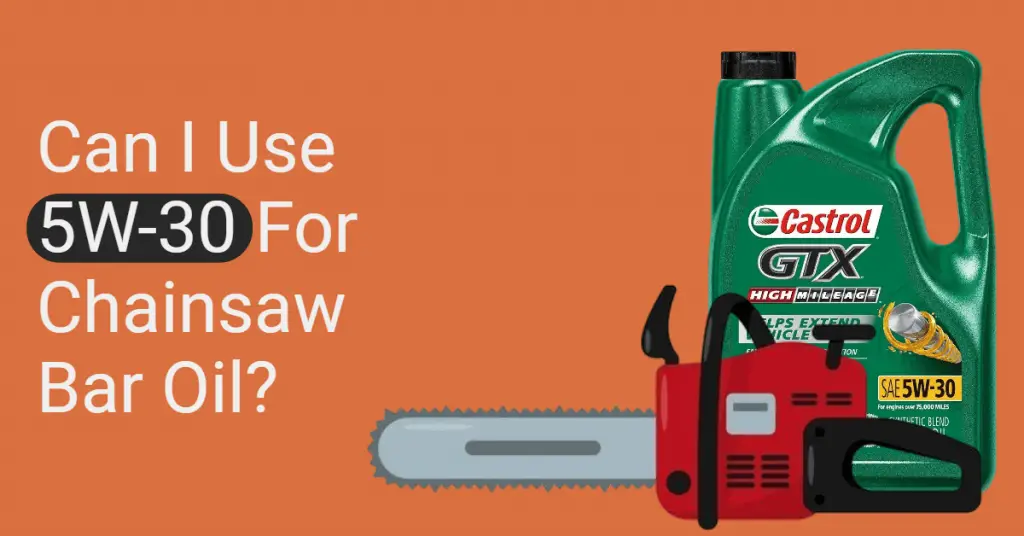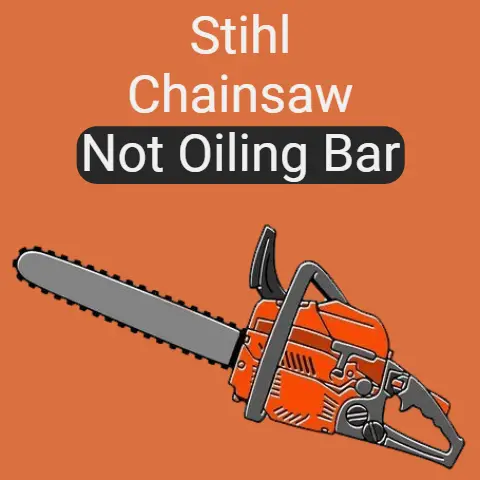Can I Use 5W-30 For Chainsaw Bar Oil? (Explained)
Chainsaw bar oil is a lubricant designed to decrease the friction between the bar and the chain.
The oil reservoir is released onto the bar the oil and the chain pick it up as it moves around the bar. It is flung in tiny droplets as it runs on the machine.

Can I use 5w30 bar oil for a chainsaw?
You can use 5w30 bar oil like 10w30 motor oil. However, the low and thin-viscosity SAE5 weight oil does not cling to the chainsaw bar and chain in the summer.
One advantage of using 5w30 like motor oil is the recommendation if you do not have around any other oil at a similar price. Automobile oil is inexpensive relatively and the quarts cost rarely more than $10.
Bear in mind that motor oil is not environmentally friendly. It gives off toxic fumes, particularly with overheating of the chainsaw on using the high-viscosity motor oils.
There are amateur chainsaw enthusiasts and forestry experts online having debated using years of motor oil in chainsaws.
However, the professionals agree that 5w30 motor oil is a wonderful alternative. It is not a solution for the long term.
What are 5w30 oil and a bar oil?
5w30 oil refers to motor oil used widely in light-duty diesel and petrol engines. Like most motor oils, 5w30 is multi-grade oil.
It ranges from the grade of 5, a lower viscosity to a grade of 30, a higher viscosity grade.
Bar oil is the type of oil that sticks to the chainsaw bar and the chain. It does not feature an SAE (Society of Automotive Engineers) grade.
It is also well-known for its weight classification, which is the same as the motor oil for your car and is rated for winter or summer use.
The bar chain oil is 30 weight as standard. As the temperatures rise, you may switch back to the chain oil and standard bar that may be around 20 and 50 weights, where the standard is 30 weights.
Using winter oil in summer may leave on the ground a lot of oil, and it is because the thinner oil does not stick to the chain and the bar.
Is it possible to run a chainsaw without bar oil?
Running without bar oil on a chainsaw causes mechanical problems, and associated are a few safety issues such as:
The chain becomes dull
The bar oil helps cut off the saw. The bar oil stickiness coats the teeth and the chain, helping the process of cutting. This friction dulls the chainsaw faster.
Even on hitting a nail using the chain, there is friction instantly to dull the chain. The bar oil decreases the heat and friction, but both dull your chain.
Kickback increases
Chainsaws are dangerous and the frequency of accidents is more due to operator error at most times.
However, know about chainsaw kickback. The kickback takes place at full throttle as the saw tip meets timber.
The kickback is not violent always and may be dangerous if the operator is not ready. There is an option to reduce the kickback by not allowing the bar tip to contact the timber. The increase in kickback is when the chain lacks the lube.
Your chain brake is designed to lock the chain and is built into the handle in the kickback event.
Thus, during a violent kickback, there is an impact automatically in engaging the brake.
Chain failure
It is a safety concern. The chain is linked like any bicycle chain. It can break if the links give away. Running a saw without bar oil increases the break chances.
However, chain oil helps in moving freely and assists in keeping the chain cool. As the chain is dry, and the links move around the bar, it wears out resulting in chain failure.
Engine load increase
The chainsaw engine overheats as a chain reaction. It works hard as the chain is dull and this causes a lack of chain oil. The risk of overheating is more as the saw is working for longer.
Increase in chain and bar wear
The bar oil does not equal the increased heat and friction. Thus, it adds to a huge increase in chain and bar wear.
The chain teeth, links, and drivers, without bar oil, wear quickly, causing teeth to break with increased friction.
The added wear causes the chain links to lose and stretch. The stretched chain needs to adjust the chain tension. The rails become concave and wear out.
Engine heat soak increase
The heat soak refers to the heat transfer from the bar and chain to the chainsaw engine and body.
The sprocket on the chain is on the engine driving the chain. It is rare for a hot saw to melt a chain brake and its other plastic components.
The two-stroke engines receive air-cooling and it suffers mostly from overheating. Besides the engine drive working hard, it adds heat soak increasing the overheating.
Common problems
- Blocked bar oil port- If so, remove the bar, clean the rail and the port hole
- Blocked saw oil port- If so, remove the chain and the bar, clean the port, saw, and check the feed.
- The wrong type of oil- It means the waste oil is causing bar oil issues and needs a full cleanout.
- Blocked oil pump feed- If so, it requires compressed air to the tank from the oil port and to clear it.
- Faulty pump- If so, replacing pumps is inexpensive and easy.
- Faulty lube hose- if so, replacing the hose is enough.
Final Thought
A super-efficient kit is a chainsaw. It is useful to tackle most big jobs with ease using a chainsaw. However, chainsaws move a sticky bar of oil from the reservoir to the bar and rotate the chain distributing the lube on the bar.
Thus, running a chainsaw without bar oil is not a recommendation. The calculation is simple: No Bar Oil= No Chainsaw.





